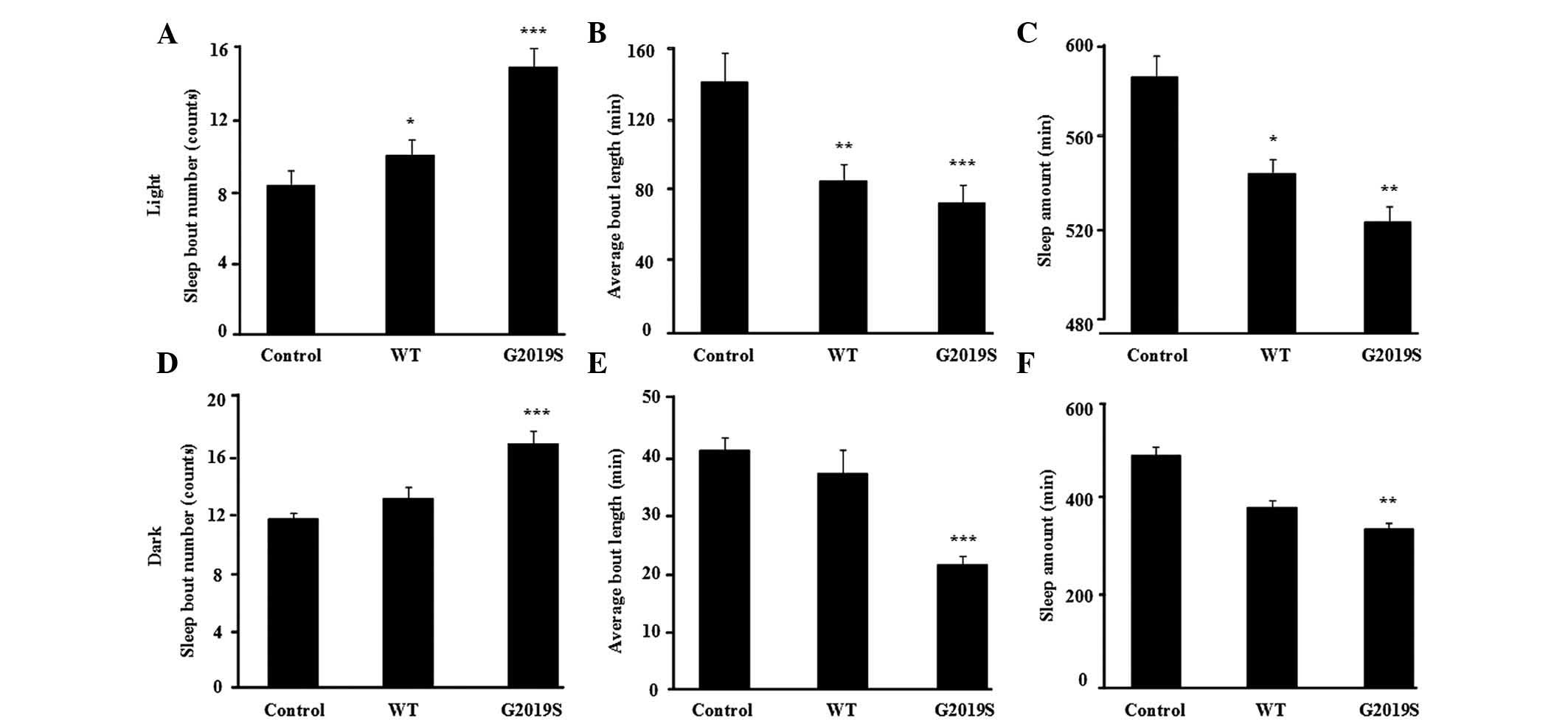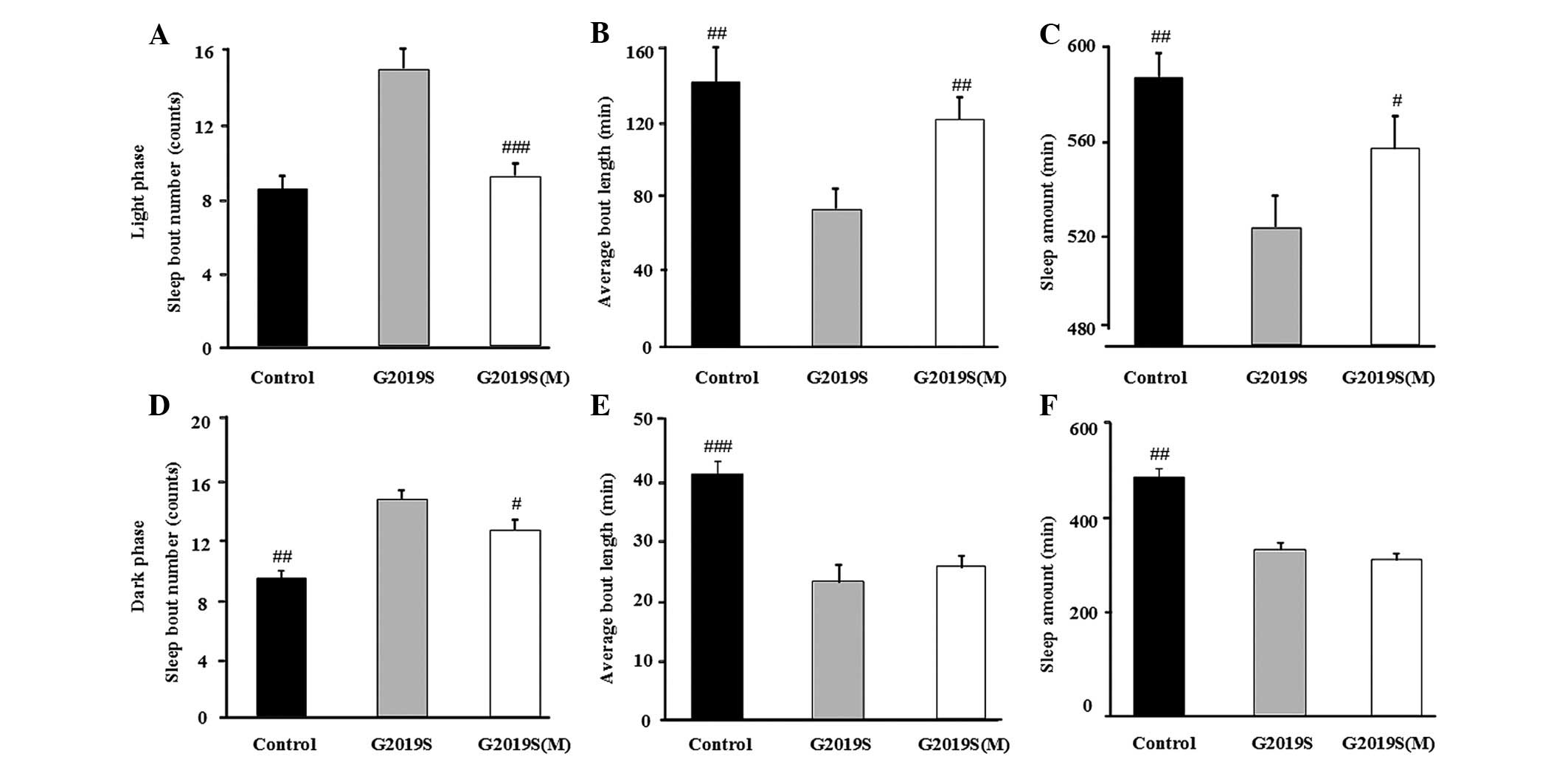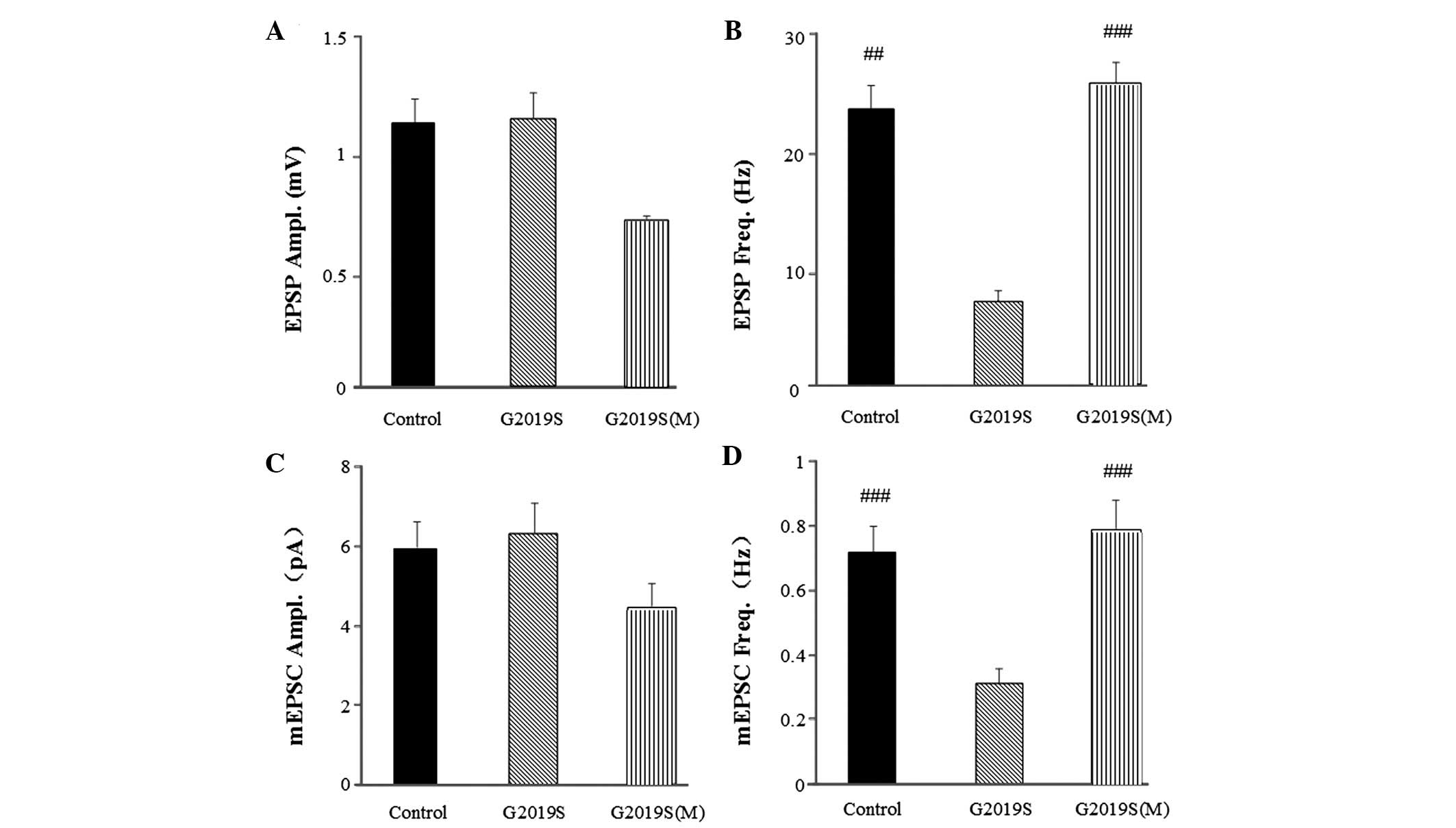|
1
|
Braak H, Del Tredici K, Rüb U, de Vos RA,
Jansen Steur EN and Braak E: Staging of brain pathology related to
sporadic Parkinson's disease. Neurobiol Aging. 24:197–211. 2003.
View Article : Google Scholar
|
|
2
|
Dauer W and Przedborski S: Parkinson's
disease: Mechanisms and models. Neuron. 39:889–909. 2003.
View Article : Google Scholar : PubMed/NCBI
|
|
3
|
Parkinson J: An essay on the shaking
palsy. 1817. J Neuropsychiatry Clin Neurosci. 14:223–236;
discussion 222. 2002. View Article : Google Scholar : PubMed/NCBI
|
|
4
|
Comella CL: Sleep disorders in Parkinson's
disease: An overview. Mov Disord. 22(Suppl 17): S367–S373. 2007.
View Article : Google Scholar
|
|
5
|
Van Hilten JJ, Weggeman M, Van der Velde
EA, Kerkhof GA, Van Dijk JG and Roos RA: Sleep, excessive daytime
sleepiness and fatigue in Parkinson's disease. J Neural Transm Park
Dis Dement Sect. 5:235–244. 1993. View Article : Google Scholar : PubMed/NCBI
|
|
6
|
Mehta SH, Morgan JC and Sethi KD: Sleep
disorders associated with Parkinson's disease: Role of dopamine,
epidemiology and clinical scales of assessment. CNS Spectr. 13(3
Suppl 4): 6S–11S. 2008.
|
|
7
|
Nausieda PA, Weiner WJ, Kaplan LR, Weber S
and Klawans HL: Sleep disruption in the course of chronic levodopa
therapy: An early feature of the levodopa psychosis. Clin
Neuropharmacol. 5:183–194. 1982. View Article : Google Scholar : PubMed/NCBI
|
|
8
|
Cookson MR: The role of leucine-rich
repeat kinase 2 (LRRK2) in Parkinson's disease. Nat Rev Neurosci.
11:791–797. 2010. View
Article : Google Scholar : PubMed/NCBI
|
|
9
|
Greggio E and Cookson MR: Leucine-rich
repeat kinase 2 mutations and Parkinson's disease: Three questions.
ASN Neuro. 1:e000022009. View Article : Google Scholar : PubMed/NCBI
|
|
10
|
Paisán-Ruı́z C, Jain S, Evans EW, Gilks
WP, Simón J, van der Brug M, López de Munain A, Aparicio S, Gil AM,
Khan N, et al: Cloning of the gene containing mutations that cause
PARK8-linked Parkinson's disease. Neuron. 44:595–600. 2004.
View Article : Google Scholar
|
|
11
|
Zimprich A, Müller-Myhsok B, Farrer M,
Leitner P, Sharma M, Hulihan M, Lockhart P, Strongosky A, Kachergus
J, Calne DB, et al: The PARK8 locus in autosomal dominant
parkinsonism: Confirmation of linkage and further delineation of
the disease-containing interval. Am J Hum Genet. 74:11–19. 2004.
View Article : Google Scholar
|
|
12
|
Berg D, Schweitzer KJ, Leitner P, Zimprich
A, Lichtner P, Belcredi P, Brüssel T, Schulte C, Maass S, Nägele T,
et al: Type and frequency of mutations in the LRRK2 gene in
familial and sporadic Parkinson's disease*. Brain. 128:3000–3011.
2005.PubMed/NCBI
|
|
13
|
Dawson TM, Ko HS and Dawson VL: Genetic
animal models of Parkinson's disease. Neuron. 66:646–661. 2010.
View Article : Google Scholar : PubMed/NCBI
|
|
14
|
Harbison ST and Sehgal A: Quantitative
genetic analysis of sleep in Drosophila melanogaster. Genetics.
178:2341–2360. 2008. View Article : Google Scholar : PubMed/NCBI
|
|
15
|
Huber R, Hill SL, Holladay C, Biesiadecki
M, Tononi G and Cirelli C: Sleep homeostasis in Drosophila
melanogaster. Sleep. 27:628–639. 2004.PubMed/NCBI
|
|
16
|
Koh K, Evans JM, Hendricks JC and Sehgal
A: A Drosophila model for age-associated changes in sleep: Wake
cycles. Proc Natl Acad Sci USA. 103:13843–13847. 2006. View Article : Google Scholar
|
|
17
|
Mackay TF and Anholt RR: Of flies and man:
Drosophila as a model for human complex traits. Annu Rev Genomics
Hum Genet. 7:339–367. 2006. View Article : Google Scholar : PubMed/NCBI
|
|
18
|
Li T, Yang D, Sushchky S, Liu Z and Smith
WW: Models for LRRK2-linked parkinsonism. Parkinsons Dis.
2011:9424122011.PubMed/NCBI
|
|
19
|
Liu Z, Wang X, Yu Y, Li X, Wang T, Jiang
H, Ren Q, Jiao Y, Sawa A, Moran T, et al: A Drosophila model for
LRRK2-linked parkinsonism. Proc Natl Acad Sci USA. 105:2693–2698.
2008. View Article : Google Scholar : PubMed/NCBI
|
|
20
|
Lee SB, Kim W, Lee S and Chung J: Loss of
LRRK2/PARK8 induces degeneration of dopaminergic neurons in
Drosophila. Biochem Biophys Res Commun. 358:534–539. 2007.
View Article : Google Scholar : PubMed/NCBI
|
|
21
|
Joiner WJ, Crocker A, White BH and Sehgal
A: Sleep in Drosophila is regulated by adult mushroom bodies.
Nature. 441:757–760. 2006. View Article : Google Scholar : PubMed/NCBI
|
|
22
|
Pitman JL, McGill JJ, Keegan KP and Allada
R: A dynamic role for the mushroom bodies in promoting sleep in
Drosophila. Nature. 441:753–756. 2006. View Article : Google Scholar : PubMed/NCBI
|
|
23
|
Fertl E, Auff E, Doppelbauer A and
Waldhauser F: Circadian secretion pattern of melatonin in
Parkinson's disease. J Neural Transm Park Dis Dement Sect. 3:41–47.
1991. View Article : Google Scholar : PubMed/NCBI
|
|
24
|
Olakowska E, Marcol W, Kotulska K and
Lewin-Kowalik J: The role of melatonin in the neurodegenerative
diseases. Bratisl Lek Listy. 106:171–174. 2005.PubMed/NCBI
|
|
25
|
Polimeni G, Esposito E, Bevelacqua V,
Guarneri C and Cuzzocrea S: Role of melatonin supplementation in
neurodegenerative disorders. Front Biosci (Landmark Ed).
19:429–446. 2014. View
Article : Google Scholar
|
|
26
|
Gu H and O'Dowd DK: Whole cell recordings
from brain of adult Drosophila. J Vis Exp. 6:2482007.
|
|
27
|
Thaler A, Ash E, Gan-Or Z, Orr-Urtreger A
and Giladi N: The LRRK2 G2019S mutation as the cause of Parkinson's
disease in Ashkenazi Jews. J Neural Transm. 116:1473–1482. 2009.
View Article : Google Scholar : PubMed/NCBI
|
|
28
|
Kumar S, Bhatia M and Behari M: Sleep
disorders in Parkinson's disease. Mov Disord. 17:775–781. 2002.
View Article : Google Scholar : PubMed/NCBI
|
|
29
|
Stacy M: Sleep disorders in Parkinson's
disease: epidemiology and management. Drugs Aging. 19:733–739.
2002. View Article : Google Scholar : PubMed/NCBI
|
|
30
|
Friedman A: Sleep pattern in Parkinson's
disease. Acta Med Pol. 21:193–199. 1980.PubMed/NCBI
|
|
31
|
Friedman JH and Chou KL: Sleep and fatigue
in Parkinson's disease. Parkinsonism Relat Disord. 10(Suppl 1):
S27–S35. 2004. View Article : Google Scholar : PubMed/NCBI
|
|
32
|
Yu SY, Sun L, Liu Z, Huang XY, Zuo LJ, Cao
CJ, Zhang W and Wang XM: Sleep disorders in Parkinson's disease:
Clinical features, iron metabolism and related mechanism. PLoS One.
8:e829242013. View Article : Google Scholar
|
|
33
|
Cirelli C: The genetic and molecular
regulation of sleep: From fruit flies to humans. Nat Rev Neurosci.
10:549–560. 2009. View Article : Google Scholar : PubMed/NCBI
|
|
34
|
Comella CL, Tanner CM and Ristanovic RK:
Polysomnographic sleep measures in Parkinson's disease patients
with treatment-induced hallucinations. Ann Neurol. 34:710–714.
1993. View Article : Google Scholar : PubMed/NCBI
|
|
35
|
Ozekmekçi S, Apaydin H and Kiliç E:
Clinical features of 35 patients with Parkinson's disease
displaying REM behavior disorder. Clin Neurol Neurosurg.
107:306–309. 2005. View Article : Google Scholar : PubMed/NCBI
|
|
36
|
Poryazova R, Oberholzer M, Baumann CR and
Bassetti CL: REM sleep behavior disorder in Parkinson's disease: A
questionnaire-based survey. J Clin Sleep Med. 9:55–59A.
2013.PubMed/NCBI
|
|
37
|
Piccoli G, Condliffe SB, Bauer M, Giesert
F, Boldt K, De Astis S, Meixner A, Sarioglu H, Vogt-Weisenhorn DM,
Wurst W, et al: LRRK2 controls synaptic vesicle storage and
mobilization within the recycling pool. J Neurosci. 31:2225–2237.
2011. View Article : Google Scholar : PubMed/NCBI
|
|
38
|
Tononi G and Cirelli C: Sleep and synaptic
homeostasis: A hypothesis. Brain Res Bull. 62:143–150. 2003.
View Article : Google Scholar : PubMed/NCBI
|
|
39
|
Rosales-Corral SA, Acuña-Castroviejo D,
Coto-Montes A, Boga JA, Manchester LC, Fuentes-Broto L, Korkmaz A,
Ma S, Tan DX and Reiter RJ: Alzheimer's disease: Pathological
mechanisms and the beneficial role of melatonin. J Pineal Res.
52:167–202. 2012. View Article : Google Scholar
|
|
40
|
Tarasenko A, Krupko O and Himmelreich N:
Reactive oxygen species induced by presynaptic glutamate receptor
activation is involved in [(3)H]GABA release from rat brain
cortical nerve terminals. Neurochem Int. 61:1044–1051. 2012.
View Article : Google Scholar : PubMed/NCBI
|
|
41
|
Giniatullin AR, Darios F, Shakirzyanova A,
Davletov B and Giniatullin R: SNAP25 is a pre-synaptic target for
the depressant action of reactive oxygen species on transmitter
release. J Neurochem. 98:1789–1797. 2006. View Article : Google Scholar : PubMed/NCBI
|

















